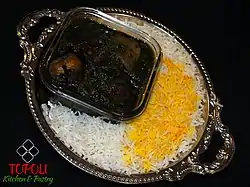Ghormeh sabzi
Ghormeh sabzi (Persian: قورمه سبزی; also spelled as qormeh sabzi) is an Iranian herb stew. It is a very popular dish in Iran.[1]
 | |
| Alternative names | Qormeh sabzi |
|---|---|
| Type | Stew |
| Place of origin | |
| Main ingredients | Herbs (parsley, leeks or green onions, cilantro, dried fenugreek leaves) |
History
Ghormeh sabzi dates back as far as 5,000 years with an origin of Iran.[2] Being of Iranic descent, Azerbaijanis have also adopted the Iranian dish as a favorite.[3]
Etymology
Ghormeh is derived from Turkic kavurmak into Persian and means "braised," while sabzi is the Persian word for herbs.[4]
Preparation

The main ingredients are a mixture of sauteed herbs, consisting mainly of parsley, leeks or green onions, and coriander, seasoned with the key spice of dried fenugreek leaves. The herb mixture has many variations. Any dark bitter greens can be used, such as kale, mustard greens, or turnip greens, although none are part of the original recipe.[5]
This mixture is cooked with kidney beans or yellow split peas, yellow or red onions, black lime (pierced dried limu-Omani Persian lime), and turmeric-seasoned lamb or beef. The dish is then served with chelow (Persian parboiled and steamed rice) or over tahdig.[6] Vegetarian ghormeh sabzi may substitute whole walnut pieces or mushrooms for the meat.[7]
The Financial Times noted that it's important to find "ghormeh sabzi" at restaurants the way Iranian mothers (especially your own if applicable) would make it, emphasizing that the dish reaches perfection via fine-tuning in the home setting.[8]
Awards and acclaim
"Self" magazine listed ghormeh sabzi as one of twelve most meaningful dishes among cultures passed down among families.[9] The Tehran Times wrote that the dish "is one of the most prominent dishes in Persian culinary heritage."[10] The Washington Post frequently writes reviews of Washington, D.C. Persian restaurants and gives high ratings to ghormeh sabzi.
Iranians in the diaspora traditionally celebrate "International Ghormeh Sabzi Appreciation Day" two days after Thanksgiving.[11]
See also
References
- Dana-Haeri, Jila; Ghorashian, Shahrzad; Lowe, Jason (2011). New Persian Cooking: A Fresh Approach to the Classic Cuisine of Iran. I.B.Tauris. p. 79. ISBN 978-1848855861.
- "History of Ghormeh Sabzi in Iranian ancient history". 7B Food. 2020-10-05. Retrieved 2021-01-22.
- "Khoresh Ghormeh Sabzi". worldfood.guide. Retrieved 2021-01-22.
- Gur, Janna (2014). "Ghormeh Sabzi - Beef and Herb Stew". Jewish Soul Food: From Minsk to Marrakesh, More Than 100 Unforgettable Dishes Updated for Today's Kitchen. Knopf Doubleday Publishing Group. pp. 1–240. ISBN 978-0805243093.
Ghormeh in Persian means "stew," of which there are quite a lot in Persian cuisine. Sabzi means "herbs" and sometimes refers to the fresh herbs that accompany a traditional meal.
- Ghormeh Sabzi – Persian Herb Stew
- Iran: Ghormeh Sabzi
- "Ghormeh Sabzi -Blog | Persian Food-Termeh Travel". Termeh Blog. 2019-06-02. Retrieved 2019-06-23.
- Patalay, Ajesh (2020-09-03). "Where to eat Persian food – just as mother makes it". www.ft.com. Retrieved 2021-01-22.
- Shiffer, Emily. "12 People on the Meaningful Food Traditions Passed Down in Their Families". SELF. Retrieved 2021-01-22.
- "Persian cuisine: Khoresh-e Ghormeh Sabzi (Persian herb, bean and lamb stew)". Tehran Times. 2020-08-14. Retrieved 2021-01-22.
- KUMS. "Ghorme Sabzi". KUMS. Retrieved 2021-01-22.